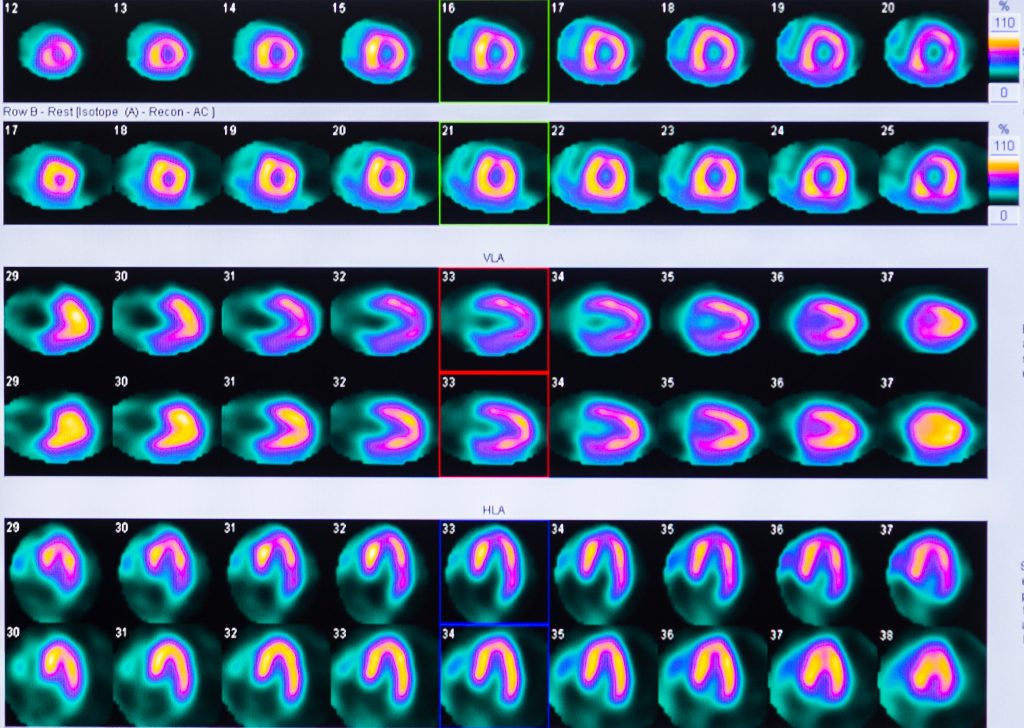
A nuclear stress test or nuclear heart scan is an imaging test that uses a harmless radioactive dye called a tracer along with imaging machines to create images of the heart. The tracer is injected into your bloodstream through a vein and travels to the heart. The tracer releases energy that can be detected by special cameras outside of your body. These cameras use the energy to create images of the blood flow to your heart. These images also allow doctors to assess how well blood is flowing to your heart.
Nuclear stress tests may be necessary if other tests were not able to confirm a diagnosis. If you have symptoms like chest pain or shortness of breath, a cardiac nuclear stress test can help determine if you have a blocked coronary artery or have damage from a previous heart attack. These tests may also be used to evaluate or guide treatment plans for patients who have already been diagnosed with heart disease.
Types of Cardiac Nuclear Stress Tests
There are two main types of cardiac nuclear stress tests used to diagnose and monitor heart conditions. The difference between the two tests is the type of scanning machine used to create the images of the heart and the types of radiotracers they use.
Cardiac SPECT Stress Test
SPECT is short for single-photon emission computed tomography. The SPECT scan works by using a special camera called a gamma camera to pick up the energy signals from the tracer, which are called gamma rays. A computer then converts the energy signals into 3D pictures.
Cardiac PET Stress Test
PET is short for positron emission tomography. A PET scan works in a similar way to a SPECT scan by using special cameras to pick up the energy emissions of a radiotracer to create 3D images. The difference is that PET scans use a different type of tracer that does not last as long as the kind used in a SPECT scan. However, PET scans often take clearer pictures than SPECT scans.
What To Expect
A nuclear stress test often includes either an exercise test or a pharmacological test. Depending on the type of radioactive tracer used, a nuclear cardiac test can take two or more hours.
Before The Test
To prepare for a nuclear stress test, follow the specific instructions your doctor gives you. Your doctor can tell you whether you need to refrain from eating or stop taking your regular medications before the test.
On the day of the test, you should wear comfortable clothing and walking shoes for the exercise portion of the test. Don’t use any lotion, cream, or oil on your skin the day of the nuclear heart scan.
During The Test
There are several steps involved in a nuclear stress test:
- An IV is inserted so that the radiotracer can be injected. It takes 20 to 40 minutes for the radiotracer to be absorbed.
- You will have your first scan while your heart is at rest.
- You will exercise or have the pharmacological test with electrodes attached to your chest, legs, and arms.
- While you exercise, your heart rate and blood pressure will be monitored.
- If you aren’t able to exercise, your doctor may give you a medication that imitates exercise called a pharmacological stress test.
- When the monitors indicate that your heart rate has peaked, you will be given another injection of the radiotracer.
- You will lie still to have another set of images taken in the PET or SPECT scanner.
- You may be asked to lie or stand still for a while with the monitors in place so your doctor can monitor you as your heart rate returns to normal.
After The Test
After the test is complete, you can return to your normal activities right away unless your doctor gives you other instructions. The tracer material will naturally leave the body in the days following the procedure.
-The physicians at Clearwater Cardiovascular Consultants have expertise in a range of outpatient cardiovascular services, including nuclear stress tests. We offer patients comprehensive care that is backed by experience, expertise, and the latest technology. Call Clearwater Cardiovascular Consultants at 727-445-1911 to make an appointment, or request an appointment online.
